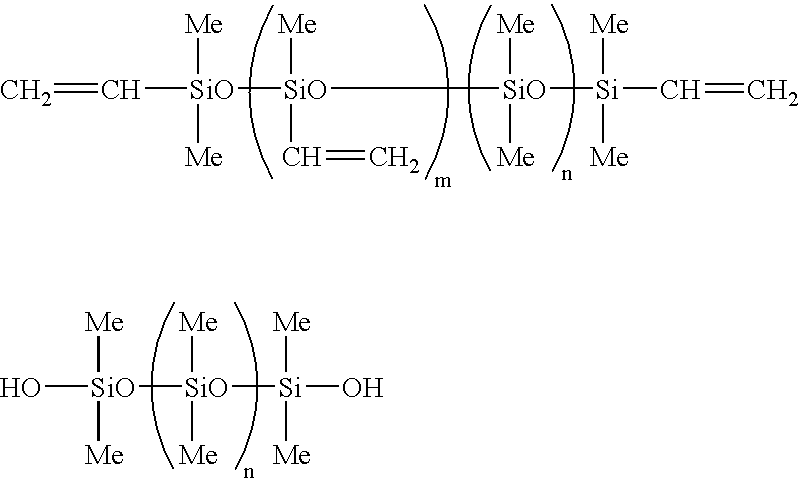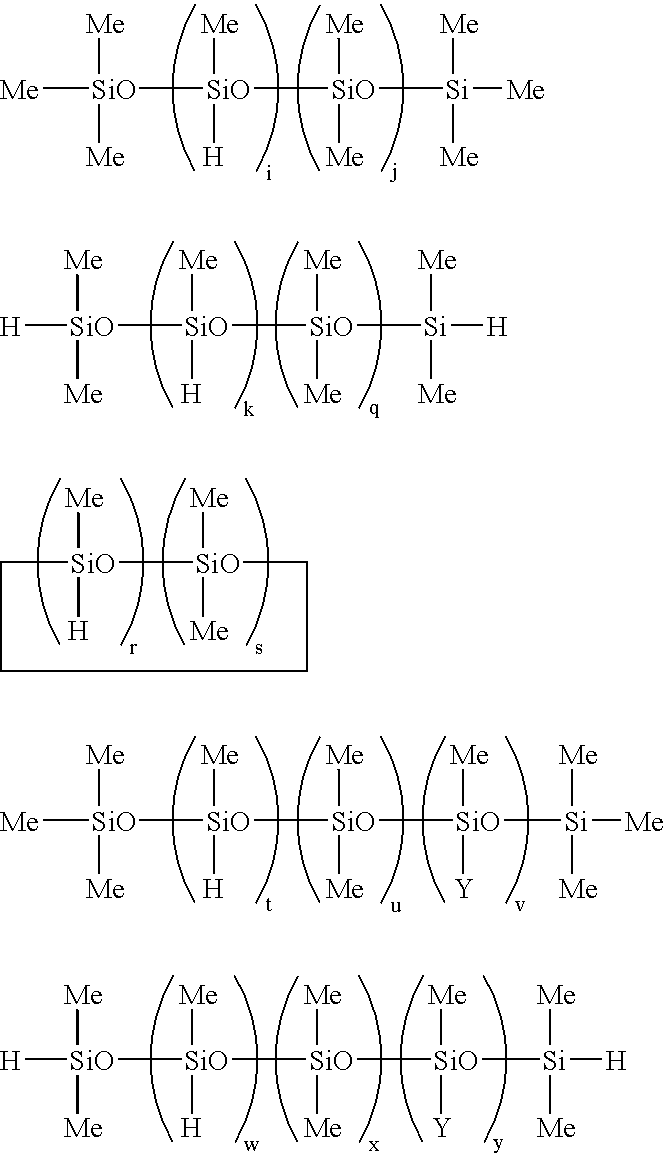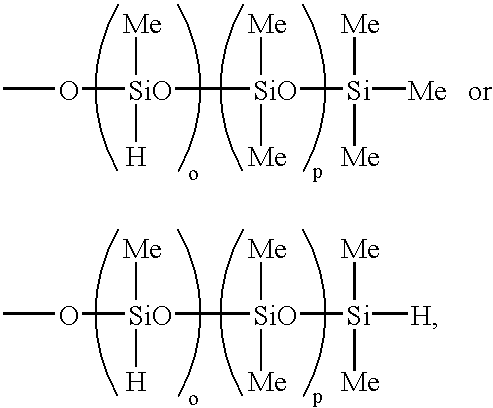Silicone coating composition and release sheet
a technology of coating composition and release sheet, which is applied in the direction of natural mineral layered products, cellulosic plastic layered products, transportation and packaging, etc., can solve the problems of poor stability of treating agent, uneven coating surface, and unsatisfactory so-called matte finish where gloss is controlled
- Summary
- Abstract
- Description
- Claims
- Application Information
AI Technical Summary
Benefits of technology
Problems solved by technology
Method used
Image
Examples
preparation example 1
of Organopolysiloxane Rubber Fine Powder
[0067] In a beaker, 500 g of methylvinylsiloxane of formula (v) below and 20 g of methylhydrogenpolysiloxane of formula (vi) below were admitted and agitated by a homo-mixer at 2,000 rpm. Then 5 g of polyoxyethylene (addition moles=9 moles) octylphenyl ether and 150 g of water were added. Agitation was performed at 6,000 rpm, during which phase reversal took place and thickening was ascertained. Agitation was still continued at 2,000 rpm, while 325 g of water was added, obtaining an O / W type emulsion. With stirring at room temperature, a mixture of 1 g of a toluene solution of chloroplatinic acid-olefin complex (platinum content 0.05 wt %) and 1 g of polyoxyethylene (addition moles=9 moles) octylphenyl ether was added to the emulsion. Reaction was effected for 12 hours, yielding a water dispersion of organopolysiloxane rubber fine particles [1]. The cake-like matter resulting from filtration of the dispersion was dried at 105.degree. C. and di...
preparation example 2
of Organopolysiloxane Rubber Fine Powder
[0068] A flask was charged with 580 g of the water dispersion of organopolysiloxane rubber fine particles [1] obtained as an intermediate in the procedure of Preparation Example 1, 60 g of aqueous ammonia (concentration 28 wt %), and 2290 g of water. With stirring by rotating a blade at 200 rpm, 65 g of methyltrimethoxysilane was slowly added over 20 minutes at 10.degree. C. The mixture was stirred for a further 4 hours at 5-15.degree. C., then heated at 55-60.degree. C. and stirred at the temperature for 1 hour. The cake-like matter resulting from filtration of the liquid was dried at 105.degree. C. and disintegrated in a jet mill, obtaining an organosilsesquloxane-coated organopolysiloxane rubber fine powder having an average particle size of 3 .mu.m.
example 1
[0069] To 100 parts by weight of an organopolysiloxane (vinyl group content=0.02 mol / 100 g) blocked with dimethylvinylsilyl groups at both ends of its molecular chain; having a main skeleton consisting of 1.5 mol % methylvinylsiloxane units and 98.5 molt dimethylsiloxane units and exhibiting a viscosity of 5000 mPa.multidot.s in a 30 wt % toluene solution at 25.degree. C. as component (A-1), was added 1800 parts by weight of toluene as component (E). The mixture was stirred at 20-40.degree. C. for dissolution. To the solution were added 3 parts by weight of a methylhydrogenpolysiloxane (H content=1.5 mol / 100 g) blocked with trimethylsilyl groups at both ends of its molecular chain, containing 95 mold of units MeHSiO.sub.2 / 2, and having a viscosity of 25 mPa.multidot.s as component (B-1), 50 parts by weight of the organopolysiloxane rubber fine powder having an average particle size of 3 .mu.m obtained in Preparation Example 1 as component (C), and 1 part by weight of 3-methyl-1-buty...
PUM
| Property | Measurement | Unit |
|---|---|---|
| particle size | aaaaa | aaaaa |
| mol % | aaaaa | aaaaa |
| viscosity | aaaaa | aaaaa |
Abstract
Description
Claims
Application Information
 Login to View More
Login to View More - R&D
- Intellectual Property
- Life Sciences
- Materials
- Tech Scout
- Unparalleled Data Quality
- Higher Quality Content
- 60% Fewer Hallucinations
Browse by: Latest US Patents, China's latest patents, Technical Efficacy Thesaurus, Application Domain, Technology Topic, Popular Technical Reports.
© 2025 PatSnap. All rights reserved.Legal|Privacy policy|Modern Slavery Act Transparency Statement|Sitemap|About US| Contact US: help@patsnap.com



